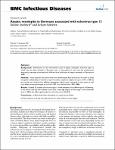Aseptic meningitis in Germany associated with echovirus type 13
Diedrich, Sabine
Schreier, Eckart
Background: Echoviruses are the commonest cause of aseptic meningitis. Echovirus type 13 which has not been isolated in Germany over a long period of time was the predominant enterovirus serotype associated with different local outbreaks of aseptic meningitis in Germany in 2000. Methods: Virus isolation was performed from cerebrospinal fluid and stools. In order to study the genetic relationship of echovirus type 13 isolates, sequence analysis of a part of VP1 (~300 nt) was carried out. Isolates from different geographic regions were compared to each other as well as to elder viruses (prototype strain from 1953, four isolates from 1965–1986). Results: Overall, 55 isolates of echovirus type 13 were obtained from different parts of Germany. It was shown that the new isolated strains have a very high degree of homology on the nucleotide level (> 98%)) but differ significantly from the old strains (76–85%). Conclusions: a) Rare enterovirus serotypes can cause serious illness. b) The molecular drift has also been shown for other enterovirus serotypes.
Dateien zu dieser Publikation
Keine Lizenzangabe

